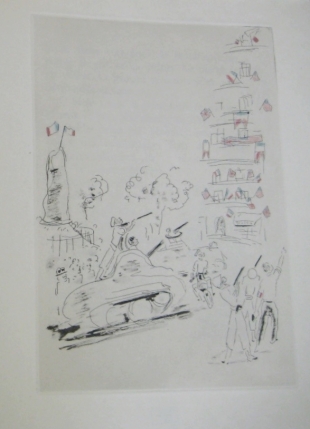 On the 75th anniversary of the Liberation of Paris, we would like to talk about Images de notre délivrance (Liberation.a.7), published in December 1944 by the Editions du Pavois (the publisher in 1946 of L’Univers concentrationnaire by David Rousset, which was awarded the Renaudot prize, Liberation.c.119 and Liberation.c.918). The book, clearly of a bibliophile nature, is presented by the editor as a documentary, the result of an accidental collaboration between a writer, Georges Duhamel (1884-1966), and an artist, Claude Lepape (1913-1994), both reacting to a unique historical event:
On the 75th anniversary of the Liberation of Paris, we would like to talk about Images de notre délivrance (Liberation.a.7), published in December 1944 by the Editions du Pavois (the publisher in 1946 of L’Univers concentrationnaire by David Rousset, which was awarded the Renaudot prize, Liberation.c.119 and Liberation.c.918). The book, clearly of a bibliophile nature, is presented by the editor as a documentary, the result of an accidental collaboration between a writer, Georges Duhamel (1884-1966), and an artist, Claude Lepape (1913-1994), both reacting to a unique historical event:
Ce livre est un document. Il est né de la rencontre fortuite de deux sensibilités. L’Ecrivain et le Dessinateur ne se sont pas concertés, mais leurs réactions, si diverses et en même temps si proches, constituent l’un des documents les plus émouvants sur les glorieuses journées de la libération.
The title itself, Images de notre délivrance (printed in blue and red on the half-title page) blurs the distinction between text and image, as it covers both the text and the illustrations.
 Duhamel describes his writing as a series of “images”, memorable, euphoric scenes collected during the historical days of August 1944:
Duhamel describes his writing as a series of “images”, memorable, euphoric scenes collected during the historical days of August 1944:
Incandescentes journées de l’Août… Images de notre grand été, nous ne vous laisserons pas glisser dans les ténèbres… vous êtes les éclatantes et magnifiques images de notre résurrection !
Duhamel’s speech, oscillating between the collective (“nous”) and the individual (“je”), aims to capture the return to life and light, after a period of darkness and trials:
Pendant plus de dix années, nous n’avons reçu que de mauvaises nouvelles…
Comme l’enfant qui reprend une à une les plus belles pages d’un album et qui les regarde en rêvant et en chantant, je veux vous aimer et vous admirer, éblouissantes images de la vie enfin revenue en nous, autour de nous, sur nous. (p. 7-9)
The text becomes album, enumeration, series of portraits, moving swiftly and enthusiastically from one image to another. In his Chronique des saisons amères, 1940-1943 (Paris, Paul Hartmann, 1944, Liberation.c.229), Duhamel also used a pictorial comparison to introduce the last section, “Figures et paysages”:
Le dernier chapitre est comparable à une galerie de tableautins… On trouvera donc là de petits portraits, des croquis et quelques paysages parisiens. (p. 8)

Duhamel is enthused by the arrival of the Leclerc division, which chases doubt and uncertainty: « Ils sont là! Cette fois nous n’en pouvons plus douter », p. 31.
Under the Occupation, three works by Duhamel, Civilisation (prix Goncourt 1918, Leigh.d.5.718), Mémorial de la guerre blanche, 1938 (1939, 534:1.d.90.29) and Positions françaises: chronique de l’année 1939 (1940, 534:1.d.90.29) had been banned by the Germans (they appeared on the Bernhard censorship list in 1940). On the title page of Images de notre délivrance, the mention of Duhamel’s membership of the Académie française (since 1935) maybe intends to emphasize the role of resistance against Petainist ideology that the author played during the Occupation in the politically divided institution.
A similar jubilation to that of Duhamel at the Liberation of Paris appears in the sharp drawings of Claude Lepape, a painter and engraver, former student of the National School of Fine Arts in Paris and the Art Students League in New York. The use of blue, white and red in his sketches (reproduced lithographically in the text; hand-colored for the full-page etchings) highlights the festive atmosphere of the meeting of French, English and American troops, and the civilian population, men and women, expressing excitement, joy, humour and movement.

Images de notre délivrance is a work of circumstance from a writer and an artist who celebrate and commemorate the collective euphoria of the Liberation of Paris in August 1944. It is one of many other books produced at that time and celebrating the event: illustrated works (see the collective Libération de Paris par la 2ème D.B.–Division Leclerc, Paris, 1945, Liberation.a.15), albums of plates (Libération de Paris, aquarelles de Pierre Albert Leroux; texte de I. Blanchot, Paris, A. Lahure, 1945, Liberation.a.16), photographic albums, documentary publications or hybrid forms (such as François Boucher, La grande délivrance de Paris, Paris, Jacques Haumont, 1945, Liberation.a.32; Claude Roy, Paris, les heures glorieuses, août 1944: le C.P.L. prépare et dirige l’insurrection, Comité parisien de la Libération, Paris, 1945, Liberation.a.24 or Jean Cocteau, La mort et les statues: photos de Pierre Jahan, Paris, Éditions du Compas, 1946, Liberation.a.8), all well represented in the Chadwyck-Healey Liberation collection.
Further reading :
Georges Duhamel (1884-1966), Paris, Mercure de France, 1967.
Georges Duhamel parmi nous, éd. Françoise Danset, Paul Maunoury et Arlette Lafay, Cergy-Pontoise, Éditions du Valhermeil, 2000. (photographic material) (2004.9.1358)
Tristan Klingsor, Claude Lepape, Flammarion, 1958.
Arlette Lafay, La Sagesse de Georges Duhamel, Paris, Minard, 1984. (738:47.c.95.682)
César Santelli, Georges Duhamel, L’Homme, L’Œuvre, Paris, Bordas, 1947.
Irène Fabry-Tehranchi


Reblogged this on penwithlit and commented:
Inspiring time- worth recalling just now!